Tom's Guide Verdict
The BenQ HT2060 is a thoroughly well rounded projector for the money. Brightness, color, contrast, clarity, and audio all come together in a system that’s flexible to meet users needs. At $999, that’s a powerful combination.
Pros
- +
Strong contrast
- +
Respectable audio
- +
Responsive gaming
- +
Serious setup flexibility
Cons
- -
Brightest setting is hideous
- -
No smart TV platform
- -
Fairly large
Why you can trust Tom's Guide
Price: $999
Screen size: 30-300 inches
Model: HT2060
Resolution: 1,920 x 1,080
Projection: LED DLP
HDR: HDR10, HLG
Refresh Rate: 120Hz
Ports: 2x HDMI 2.0, 1x USB
Audio: 2x5W
Smart TV Software: n/a
Size: 14.4 x 9.6 x 4.6 inches
Weight: 7.9 lbs.
BenQ is a major player in the projector space, and though its projectors aren’t always the most exciting — particularly where visual appeal of the hardware is concerned — it can offer a compelling package. That’s just what the BenQ HT2060 is.
At $999, it’s not nearly as expensive as some home cinema projectors, but it’s quite capable. It has ample hardware adjustment for setup, so you can place it wherever is convenient and still square your projection with the wall or projector screen. The image it pairs with that projection is actually quite pleasing for the price, even if it’s not 4K, and it has respectable sound to match.
It’s not quite a home theater in a box that some of its competitors are, like the Xgimi Horizon Pro, but it could make a strong display option for anyone looking to get a huge picture to game and entertain on with a limited budget. As you’ll see in our BenQ HT2060 review, it’s one of the best projectors for the money.
BenQ HT2060 review: Pricing and availability
The BenQ HT2060 launched in early 2023 and is widely available now for $999. You can find it on Amazon, Best Buy, Adorama, B&H, and CDW.
BenQ HT2060 review: Design
The BenQ HT2060 strikes a satisfying balance between the office-esque white plastic found on many projectors and a more stylish aesthetic that fits better into the home. While the top, sides, back and bottom are all white plastic, BenQ has opted for a silver front panel that immediately upgrades the visual appeal. There’s also a consistent vent pattern on the front and sides. The vents are quite wide and are likely to let a lot of dust and hair accumulate over time, though, but they’ll also let the two 5-watt speakers on either side fire out sound largely unimpeded.

The top of the projector offers a number of controls for navigating the settings menus or quickly adjusting the keystone (digitally).
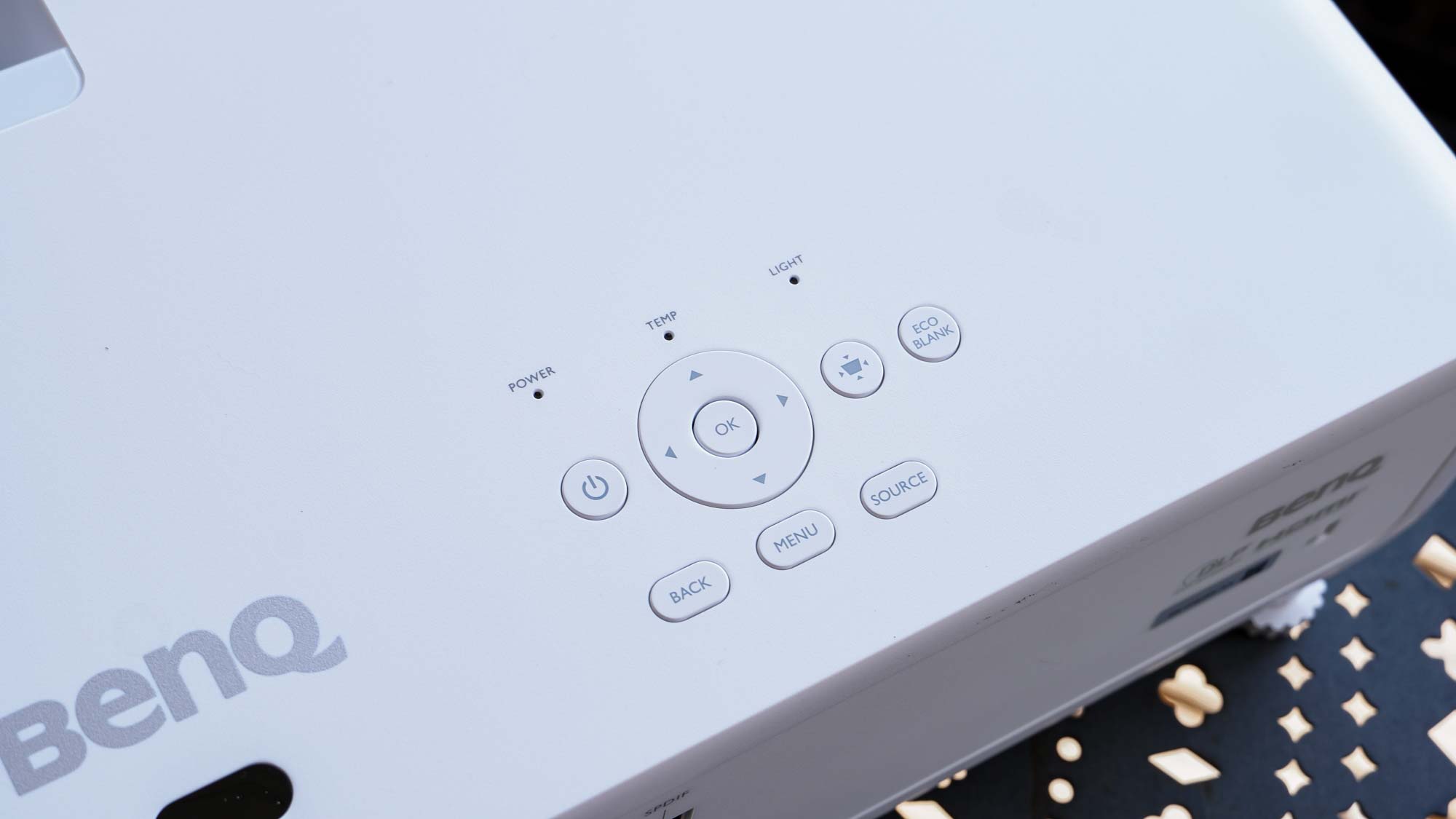
There’s also a little port that reaches down toward the lens and offers access to manual zoom and focus rings as well as a dial for vertical lens shift. Though the lens doesn’t have a cover, it sits fairly recessed inside the chassis, so it’s unlikely to have something accidentally come into contact with it. The top and front of the projector also include ambient light sensors.
Get instant access to breaking news, the hottest reviews, great deals and helpful tips.
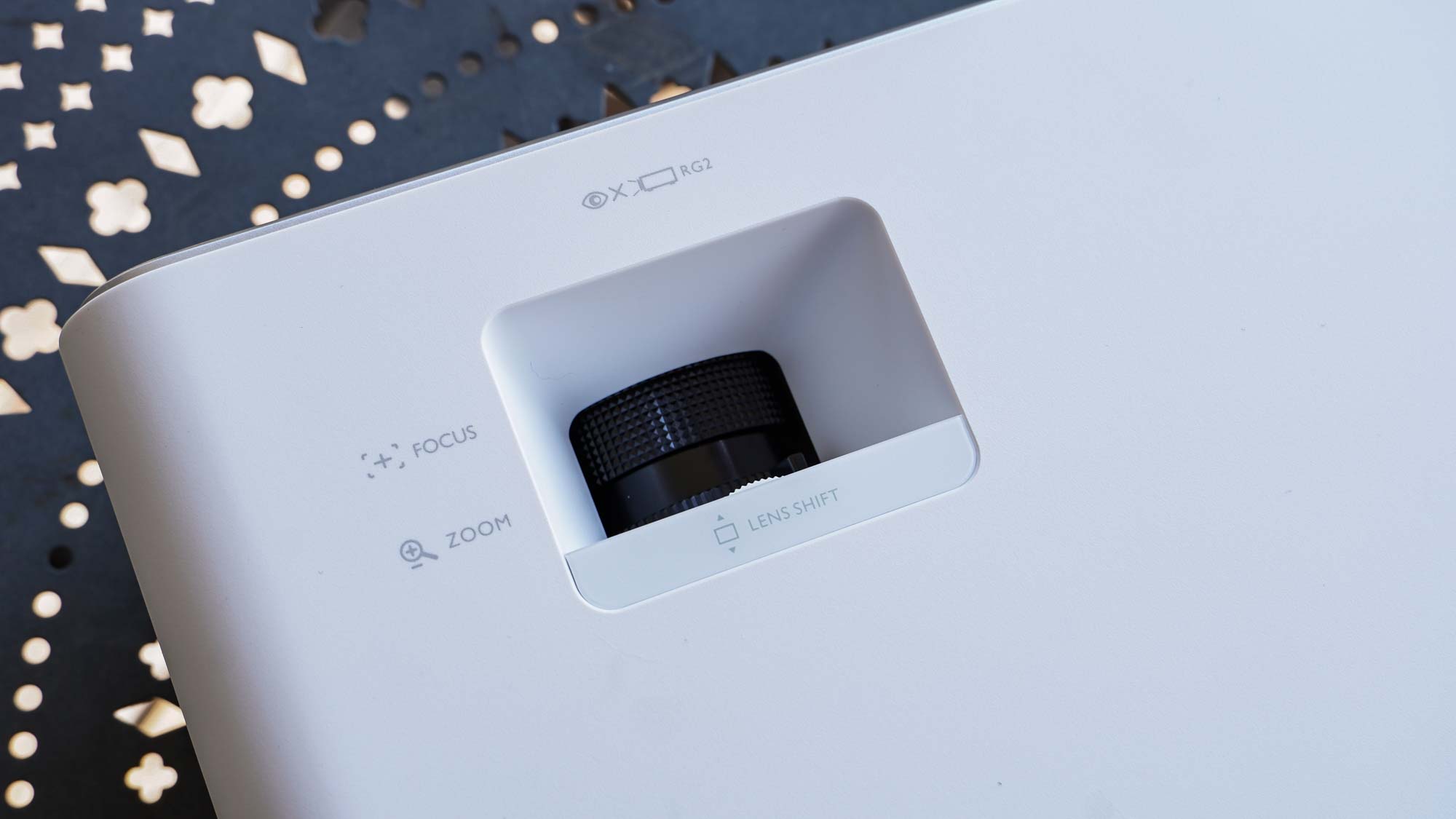
The underside of the BenQ HT2060 is nothing terribly exciting, except to the mechanically minded. There are three rubber feet that screw into the bottom, offering slight angle adjustments. The front foot also has a release lever, so you can quickly slide it up or down to make macro adjustments and then screw it to make micro adjustments. Three more holes provide attachment points for a mount, and BenQ conveniently labels the necessary screw type (M4 x 8mm). There’s even a point on the base marking the projector’s center of gravity — nifty info in case you want to precariously balance it atop a thin pole.
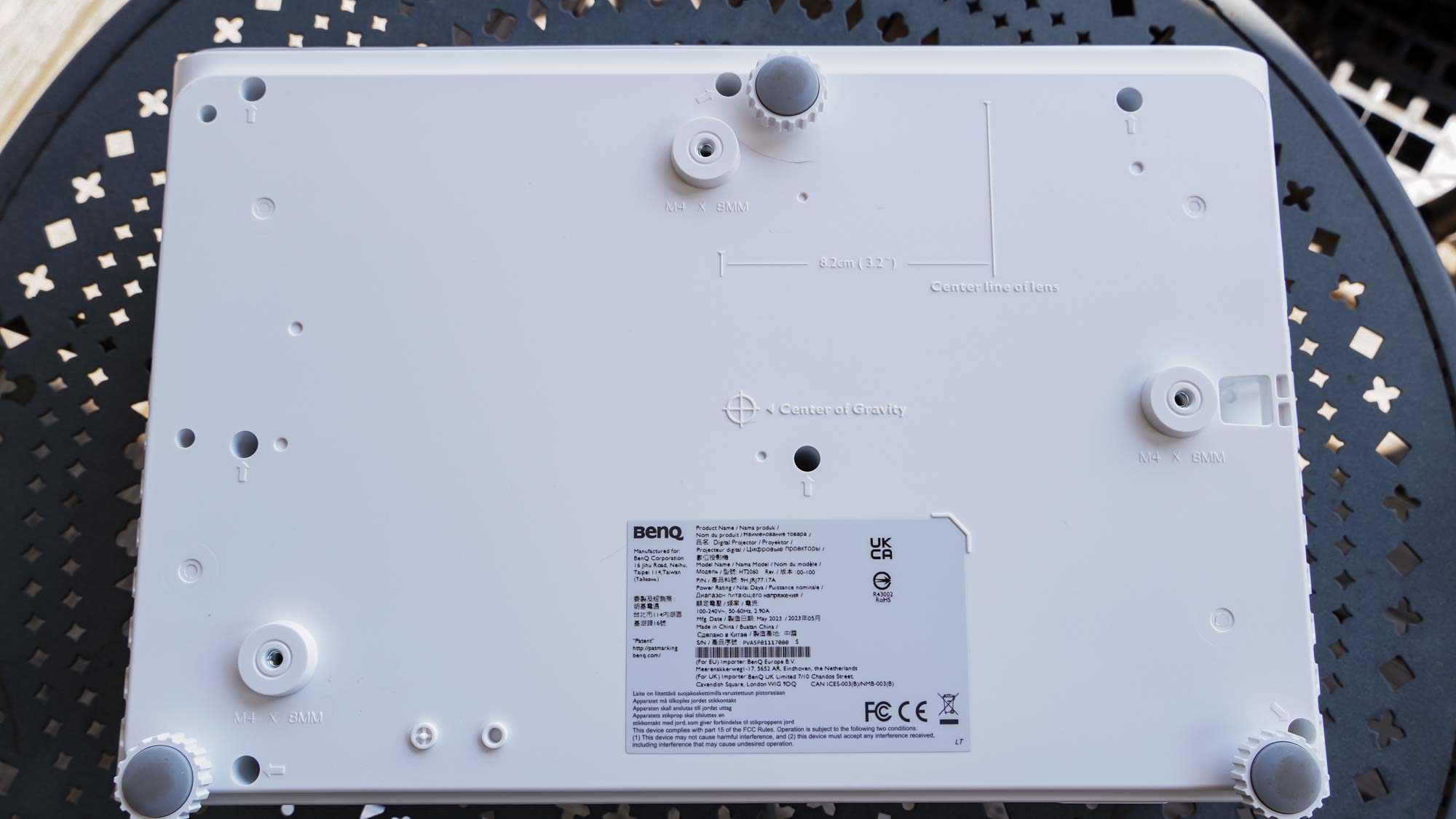
You’ll find two HDMI 2.0 ports on the rear of the projector. For audio, you’ve got optical and 3.5mm outputs as well as 3.5mm input. There are both USB and RS-232 service ports as well. Unfortunately, there’s no ARC or eARC on deck.
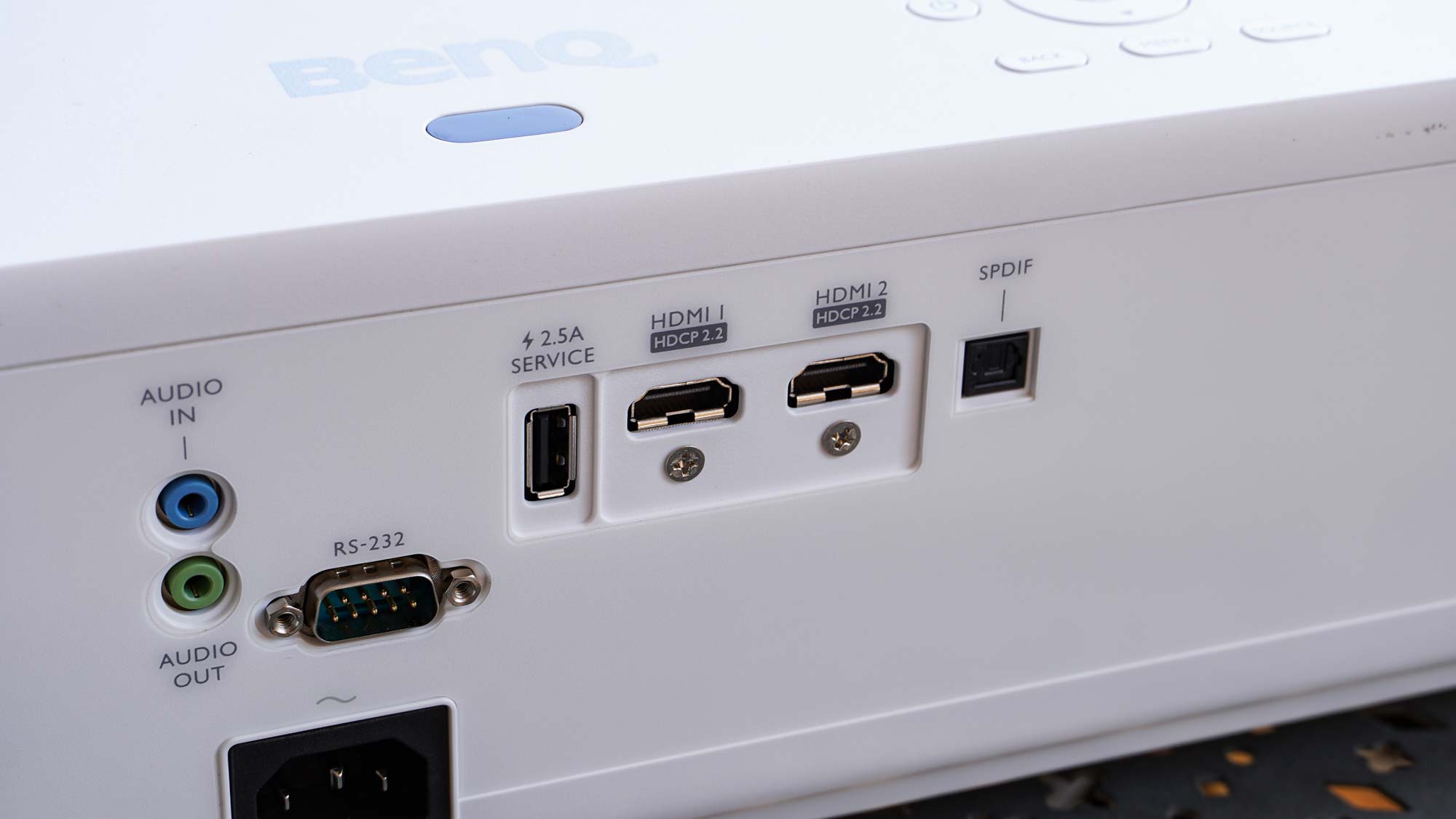
The BenQ HT2060 is a little large, but it uses some of its size to integrate a power supply, so you won’t have to deal with an external power brick.
BenQ HT2060 review: Performance
The BenQ HT2060 doesn’t have masterful presentation, but it’s quite good considering the price. You’ll have to make sure you’ve quashed most of the ambient light in order to enjoy a good picture because, as I’ll get into later, the projector’s highest-brightness mode is so awful that you’ll be stuck settling for its normal mode, which hits closer to 1,000 lumens. Watching a brighter show, like the latest season of Archer, comes with passable visibility even with a bit of daylight seeping into the room, but the HT2060 isn’t incredibly bright and therefore can’t provide enough contrast if it’s not projecting in a dim or dark room.
Supposing you do give the BenQ HT2060 a dark room to work with, you’ll be properly rewarded. This projector offers impressive contrast, avoiding the fairly washed out black that some projectors run into. This makes for a more dramatic picture. In a lot of scenarios, it feels like the projector has some near-black crush, making it hard to get much detail in dark scenes, but it looks better than the alternative.

Watching Netflix’s Kate, the neon-laden streets glowed brilliantly against the dark backdrop of night time in Tokyo. The projector kept up well with the intense action throughout the movie as well. Switching over to the action of Disney’s Andor, the HT2060 does a respectable job presenting space as well as the vibrant worlds explored by the show. Colors come through naturally without obvious oversaturation. That’s good news for everyday content, but can leave the most colorful films, like Avatar 2, feeling a bit less rich.

The 1080p resolution of the HT2060 is one shortcoming with a variable presence. The bigger the picture, the more noticeable it’s liable to be. Stretching toward a 80-100-inch picture, the visuals are still pleasing, though a softness in fine details is noticeable. Thankfully, pixelation isn’t terribly noticeable. What’s more apparent is a sort of swimming-pixel effect I’ve seen on many DLP projectors that looks like each pixel is wiggling around in a tight area. The bigger the picture, the easier it is to see, and it shows itself most on large swathes of a single color, hiding better in fine details. It’s less distracting on this projector than others I’ve tested, though.
BenQ HT2060 review: Test Results
The BenQ HT2060 is no slouch when it comes to brightness. It’s not the utter brightest you’ll find, but I measured it at 1,645 ANSI lumens. This measurement is gathered by using a light meter to take lux measurements at 9 points across an all white image and multiplying it by the area of the projected image. However, this brightness is achieved in a special bright mode that kicks the projector into high gear, throws image quality out the window, and causes some coil-whine like squealing. The picture is awful in this mode. Back in a normal mode, the brightness hit 1,014 lumens
| Row 0 - Cell 0 | BenQ HT2060 | JMGO N1 Ultra | XGIMI Horizon Pro | Optoma GT2100HDR | Dangbei Mars Pro 4K | Epson Home Cinema 3800 | Xgimi Horizon Ultra |
| Brightness (ANSI lumens): | 1645 | 2143 | 1270 | 3012 | 1812 | 2375 | 1296 |
| Contrast: | 3253:1 | 1577:1 | 757:1 | 2370:1 | 1105:1 | 2055:1 | 250:1 |
| sRGB coverage: | 99% | 100% | 100% | 90% | 92% | 91% | 100% |
| DCI-P3 coverage: | 87% | 96% | 83% | 74% | 75% | 76% | 90% |
| Input lag (default): | 25ms | 144ms | 144ms | 26ms | 152ms | 24ms | 145ms |
| Input lag (gaming mode): | 25ms | 28ms | 24ms | 25ms | 27ms | 24ms | 26ms |
| Lifespan: | 30,000 hours | 30,000 hours | 30,000 hours | 30,000 hours | 30,000 hours | 5,000 hours | 2,5000 hours |
I also take a rough measure of contrast by comparing the average lux reading of the all white screen against the lux reading of an all-black image. In the case of the BenQ HT2060, it offered an impressive 3252.7:1 contrast ratio in its unsightly bright mode. In its normal mode, it still hits a solid 2,913:1.
Making matters even better for this projector, it manages respectable color. Using a SpyderX Elite colorimeter with DataColor’s testing software, I measured color gamut against a 1.1-gain projector screen. For the BenQ HT2060, this showed 99% coverage of the sRGB color space and 87% coverage of DCI-P3. This isn’t quite on the level of tri-color laser projectors, but it’s enough for pleasingly colorful visuals.
BenQ HT2060 review: Audio
You’ll be getting an acceptable audio package for the basics with the BenQ HT2060 and that’s a big plus for a $1,000 projector. The sound system is appropriately matched with the picture and easily overwhelms the faint blowing of the projector’s fans. It can readily serve in a 100 to 200 square foot room with stereo sound. Every now and then, I was even surprised by the effect it had while gaming, with some sounds really feeling like they were coming from around me.
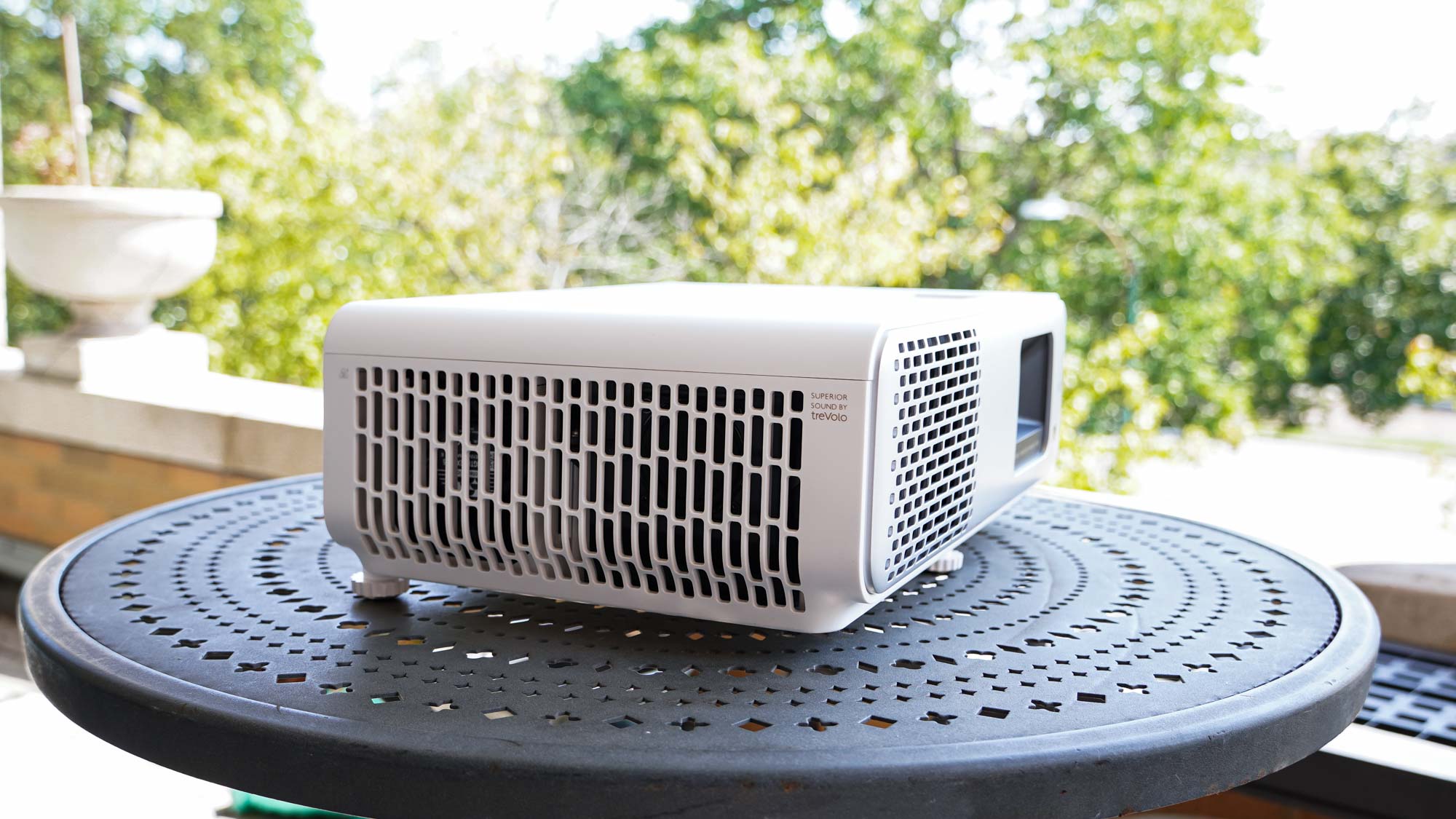
The range of the speakers is also impressive. They don’t go terribly deep into the bass range, but they go deep enough to offer a fullness you won’t get from smaller speakers. That pairs with good performance in mids and treble, and no noticeable distortion even with the speakers cranked to the limit. For a show like Daisy Jones & The Six, the speakers were as compelling for the drama and fights as they were for the many musical numbers.
BenQ HT2060 review: Gaming
Gaming is one of the strong suits of the BenQ HT2060 thanks to its ability to ratchet up to a 120Hz refresh rate when connected with compatible hardware. The display still has a faint bit of ghosting noticeable behind fast moving objects on screen, but is otherwise speedy and responsive. Latency is also particularly low, measured at just 25 milliseconds when comparing a timecode cloned to run side by side on a 90Hz OLED display and the projector.

The 120Hz mode is ideal if you’re going to try playing shooters or competitive titles where twitchy reflexes are essential. It was enough to get by in a quick match of Counter Strike: Global Offensive without feeling hampered by a lack of responsiveness from the display — just my rusty gameplay.
Outside of fast-refresh gaming, the BenQ HT2060 is still reasonably capable. The low input lag was crucial for surviving the wilds as I explored Horizon: Forbidden West on a PS5. Being able to respond quickly to threats never felt like an issue with the projector. Meanwhile, my exploration was a pleasure on the eyes as the game world was rendered pleasingly by the high-contrast and colorful projection.
BenQ HT2060 review: Smart TV Interface
The BenQ HT2060 has no smart TV interface. Rather, it has a simple UI for controlling its display processing and sound. To get up and streaming or gaming with this projector, you’ll need to attach your own video source to one of its two HDMI ports.
BenQ HT2060 review: Remote control
The remote for this projector is rather large compared to what you’ll often find with Android TV-powered projectors. That said, it has its benefits. For one thing, the remote includes backlit buttons that glow a subtle orange, allowing you to actually see what each button does in the dark room you’re likely to use the projector in.
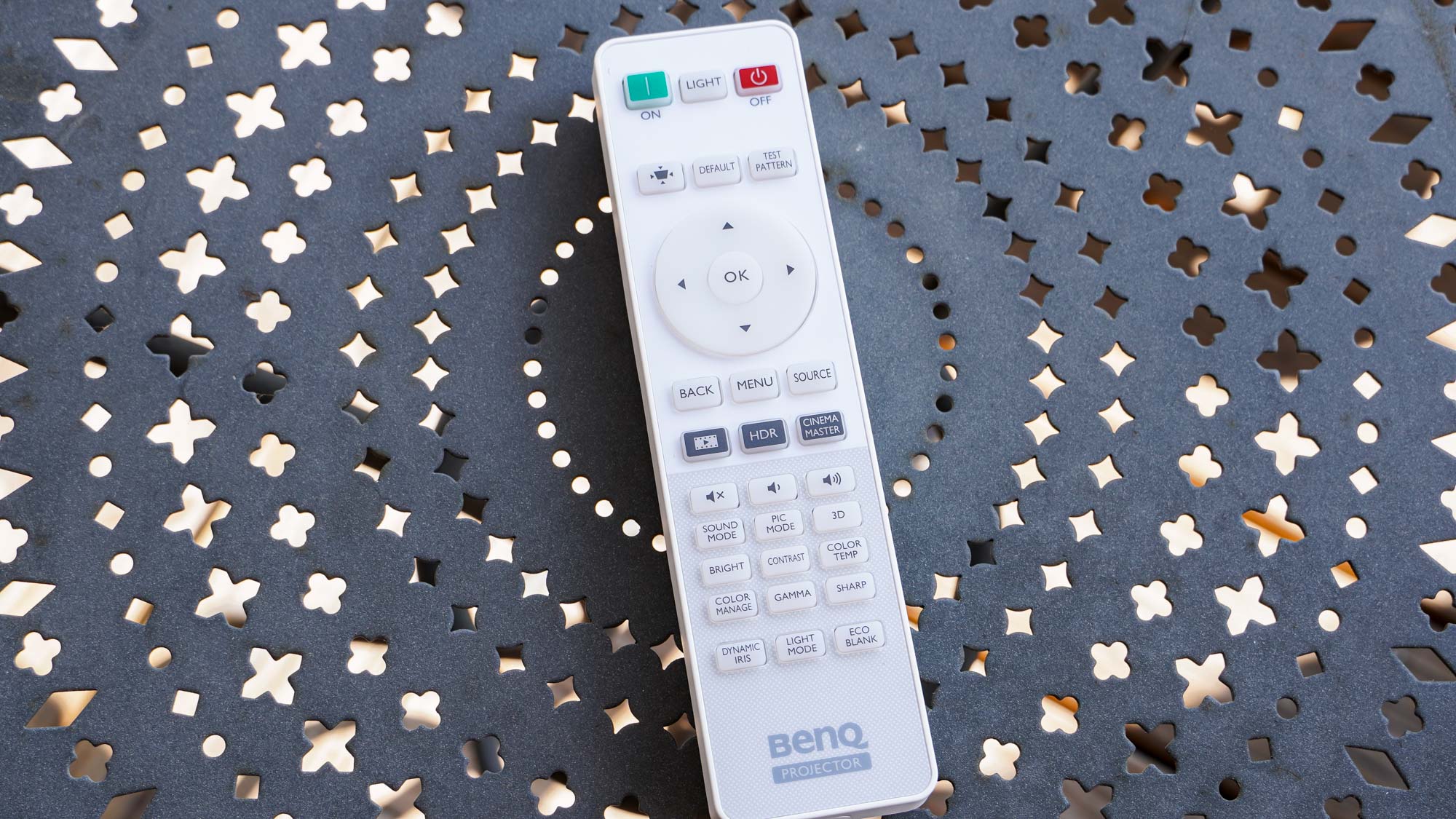
The remote’s buttons are largely focused on easy navigation to and through settings menus, with many shortcuts directly to various settings. This makes adjusting the picture a quick process. That said, some of the buttons won’t always do anything, such as the HDR button, depending on the video source.
BenQ HT2060 review: Verdict
The BenQ HT2060 is an impressively well-rounded package. It’s a bit large and has some office-space DNA, but BenQ has done enough to the design to keep it from being an eyesore in the living room. It’s also far more flexible in setup than many of the stylish cube projectors it competes with, like the Xgimi Horizon Pro.
What the HT2060 may lack in brightness it makes up for in contrast, offering a dramatic and impactful picture in dim and dark rooms. It even has sound that can keep up with the picture it offers, making it that much easier to use without a bunch of external connections. You will need your own video source, though, as there’s no smart operating system baked in, but that’s not a huge downside, as a $50 Chromecast with Google TV is usually better than the Android TV systems running on projectors.
While the HT2060 might not be a monumental projector for the home theater aficionado, it’s definitely a serviceable pick for someone who wants a good value with all it can do for $1,000.
Over the last several years, Mark has been tasked as a writer, an editor, and a manager, interacting with published content from all angles. He is intimately familiar with the editorial process from the inception of an article idea, through the iterative process, past publishing, and down the road into performance analysis.

